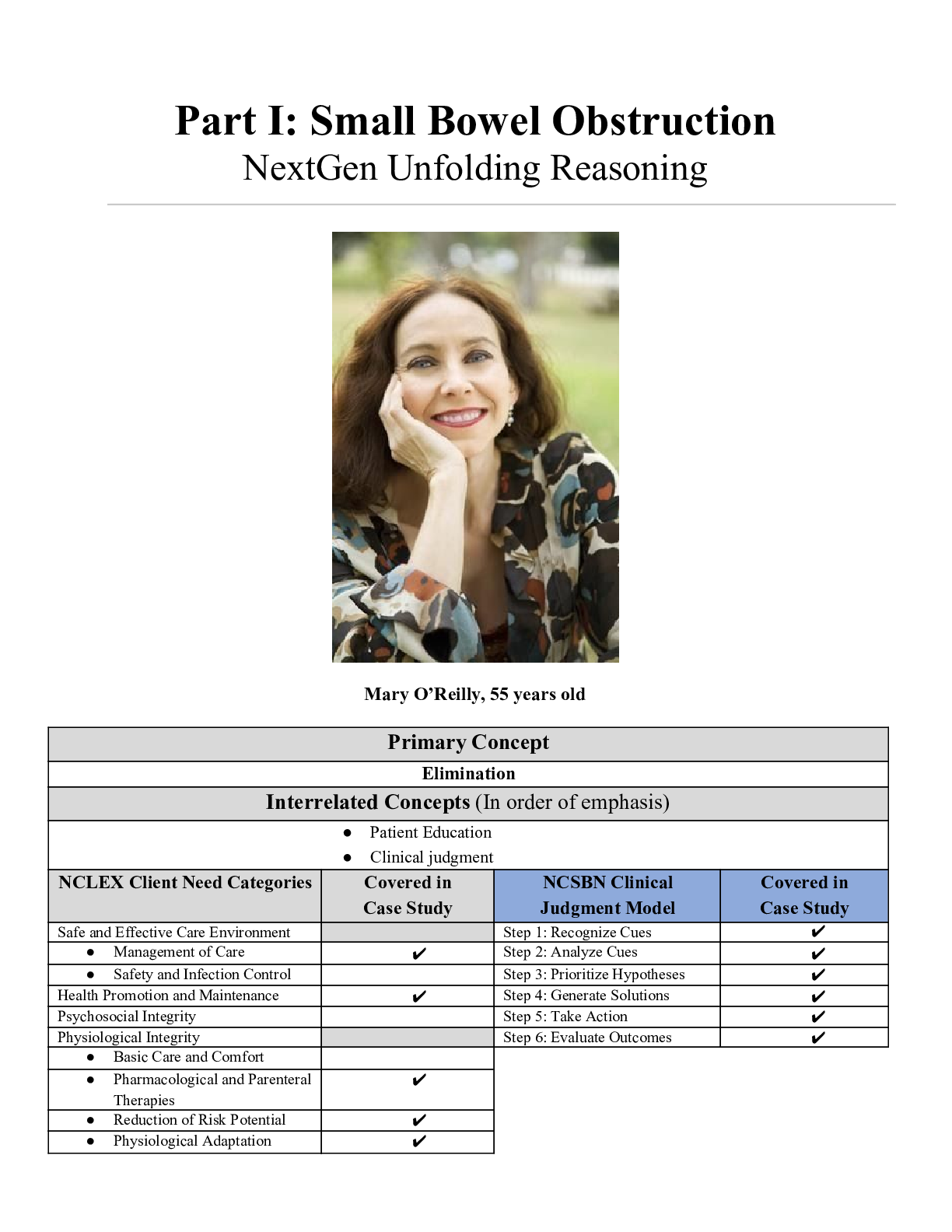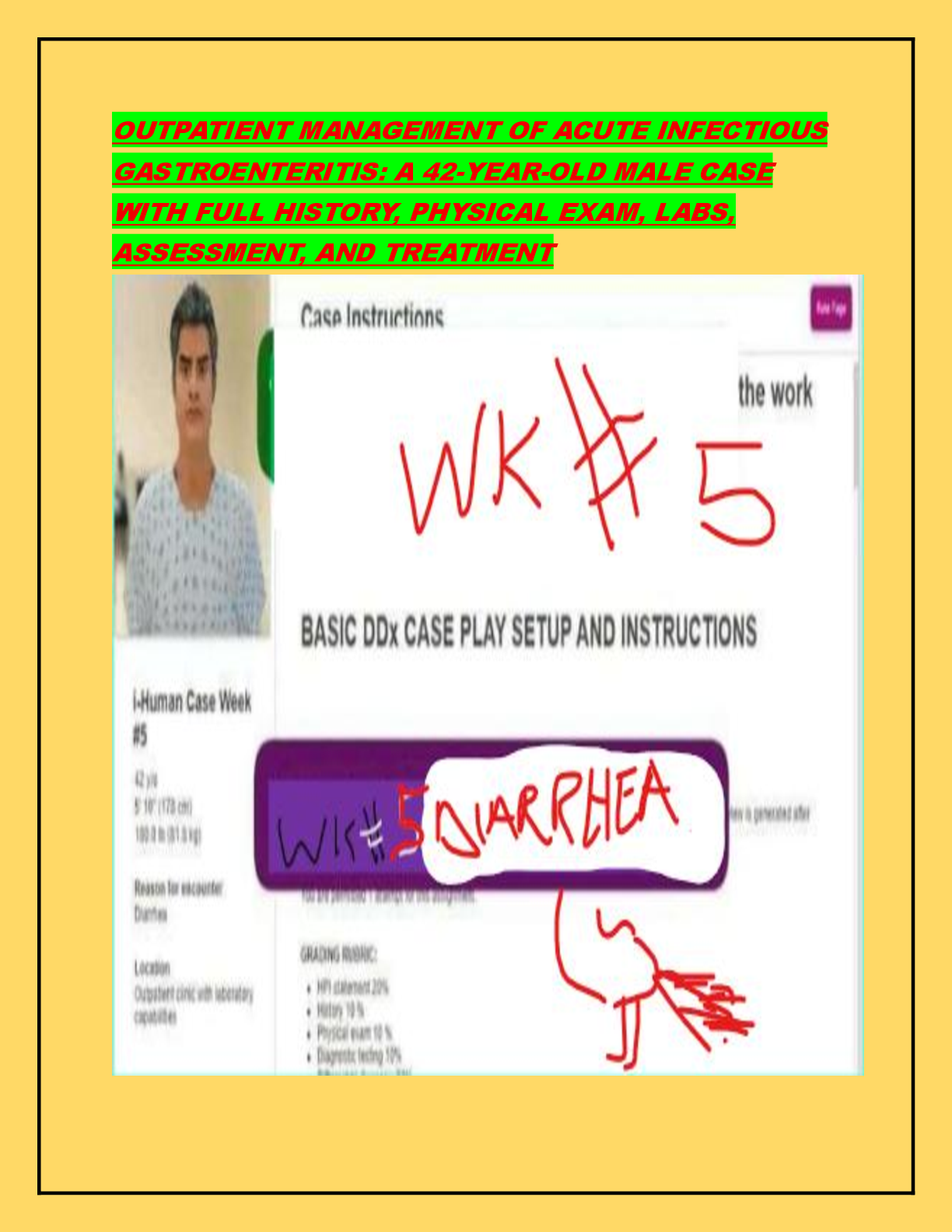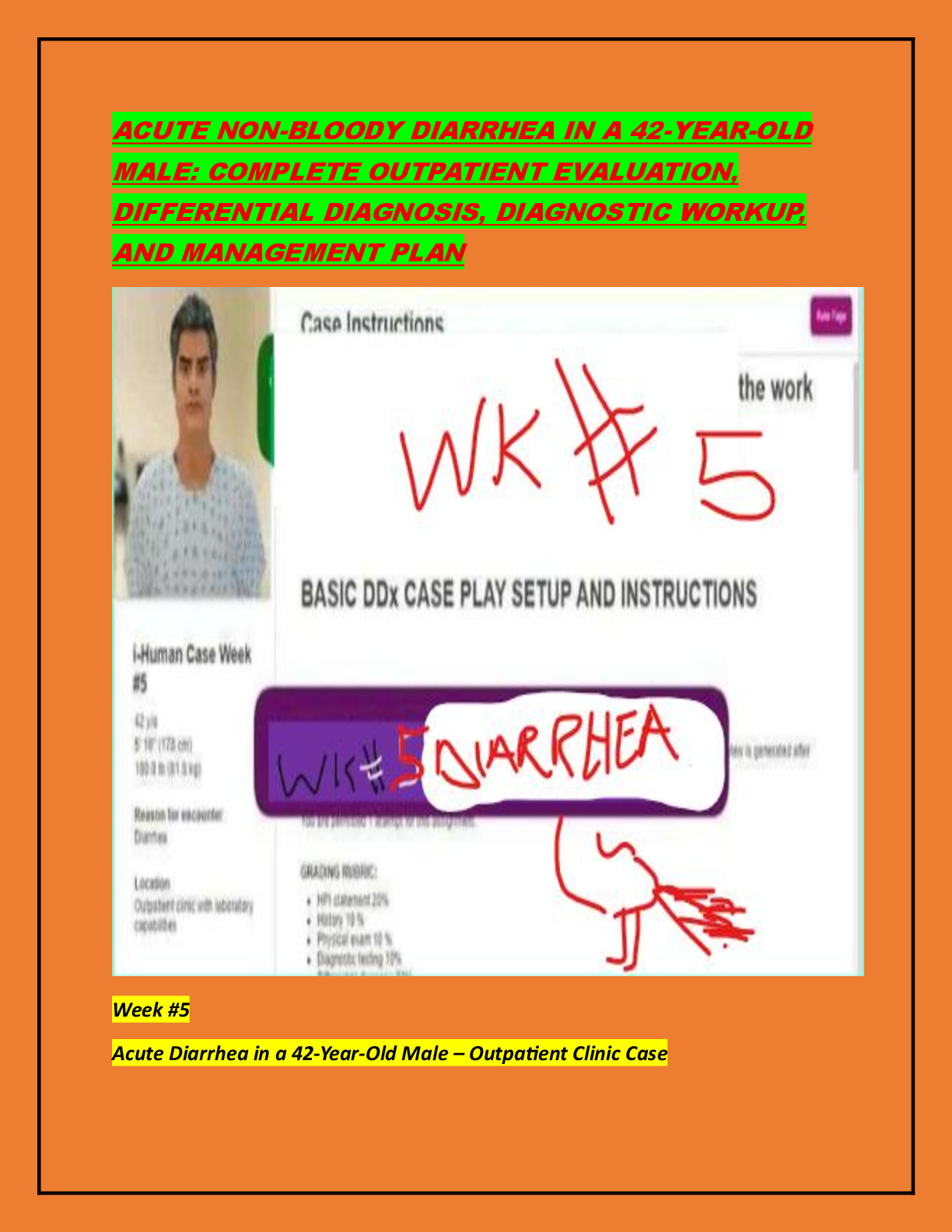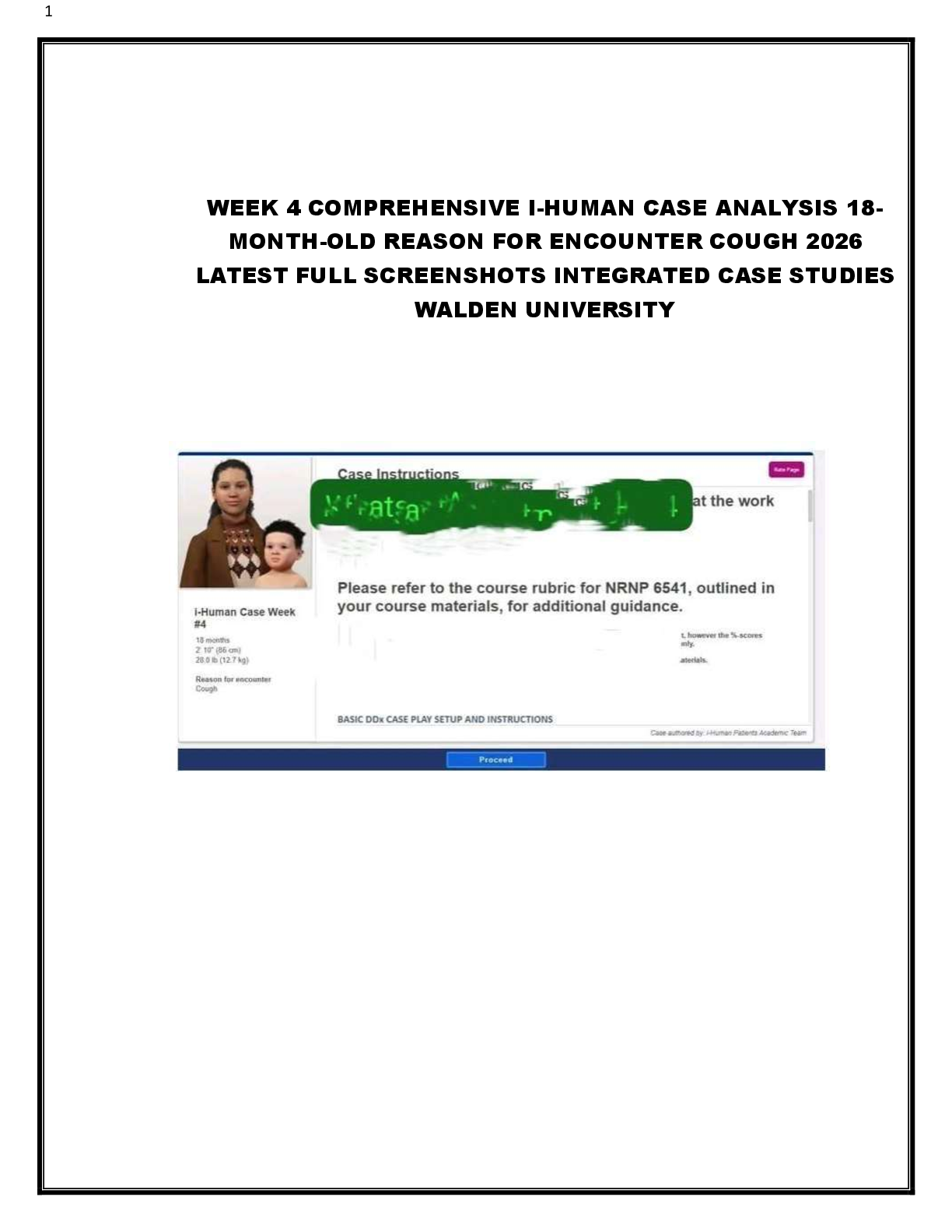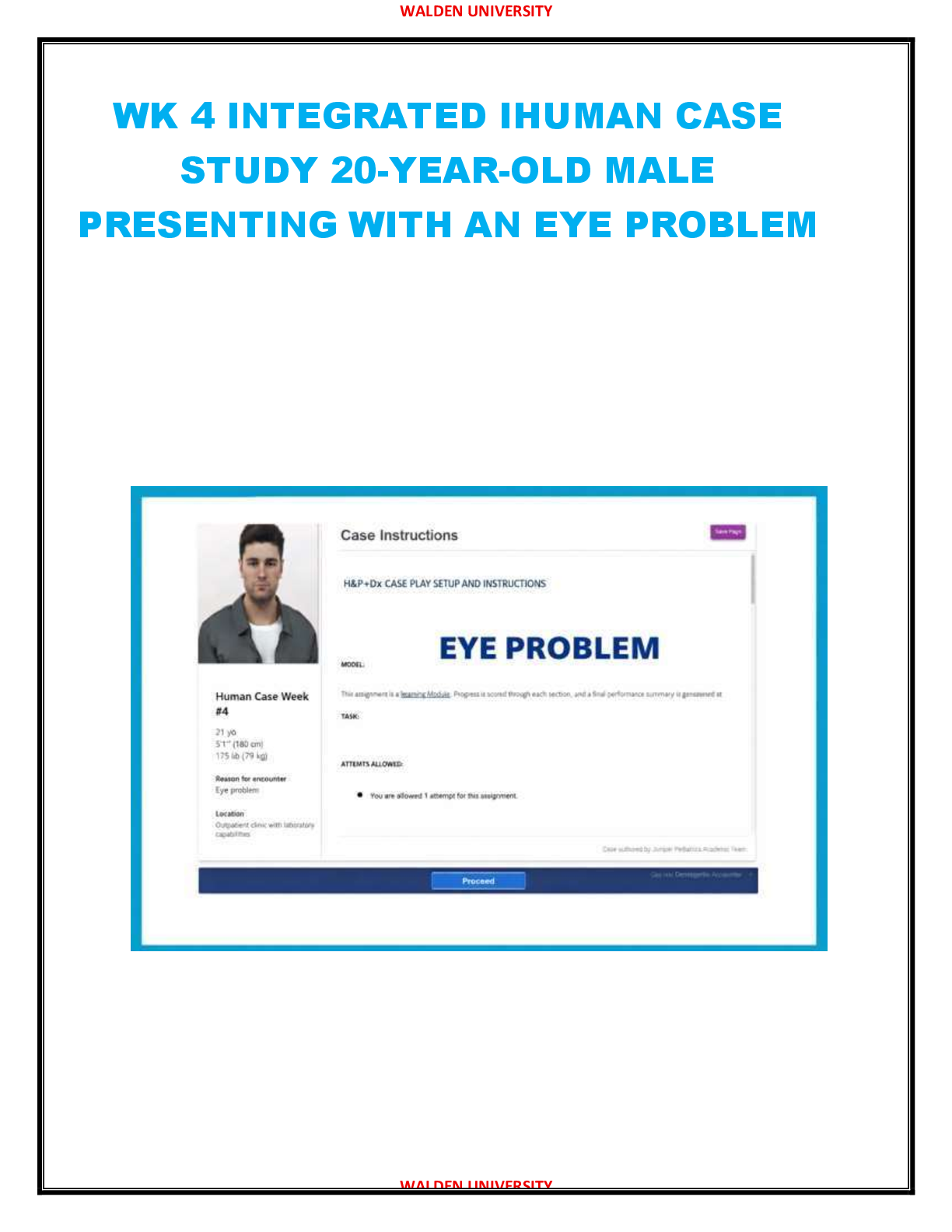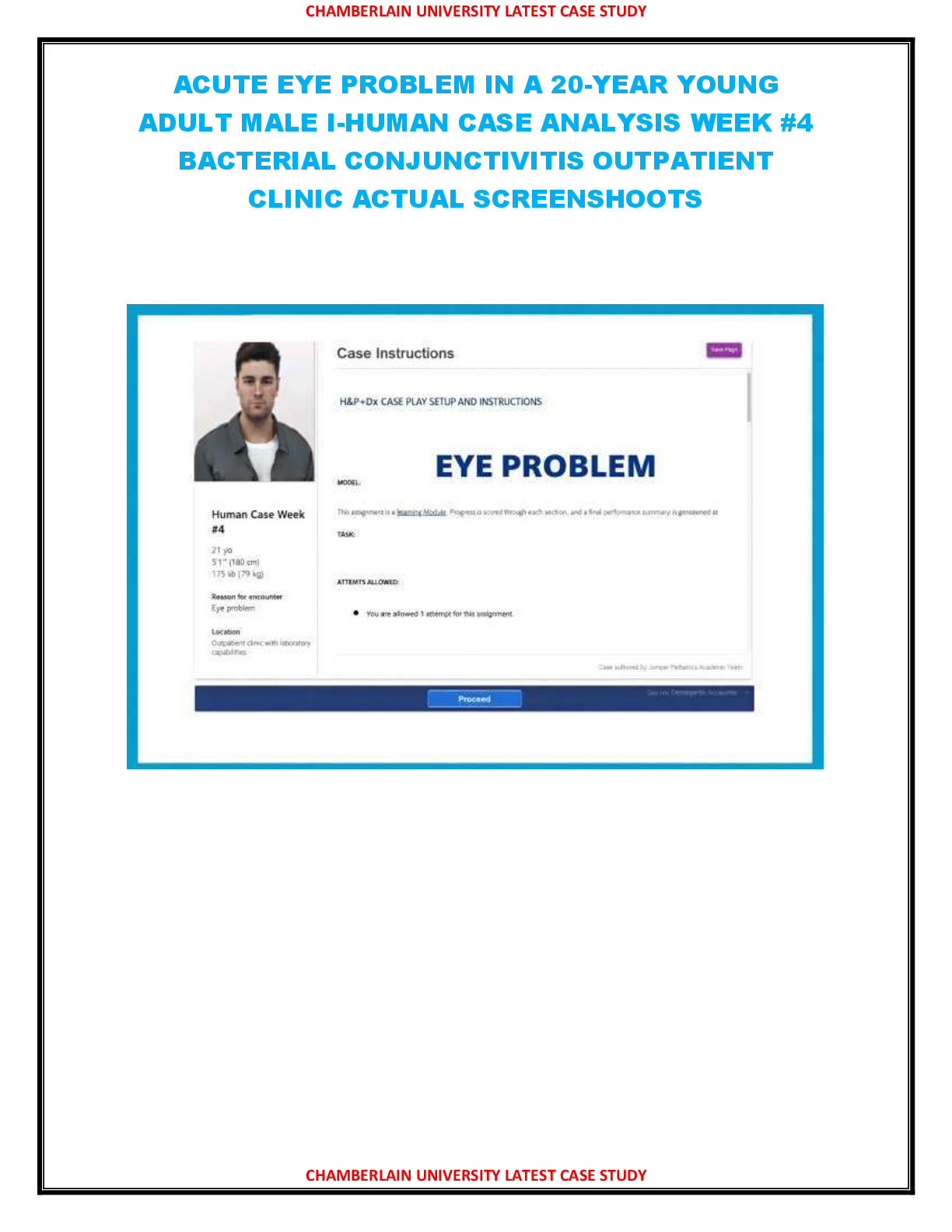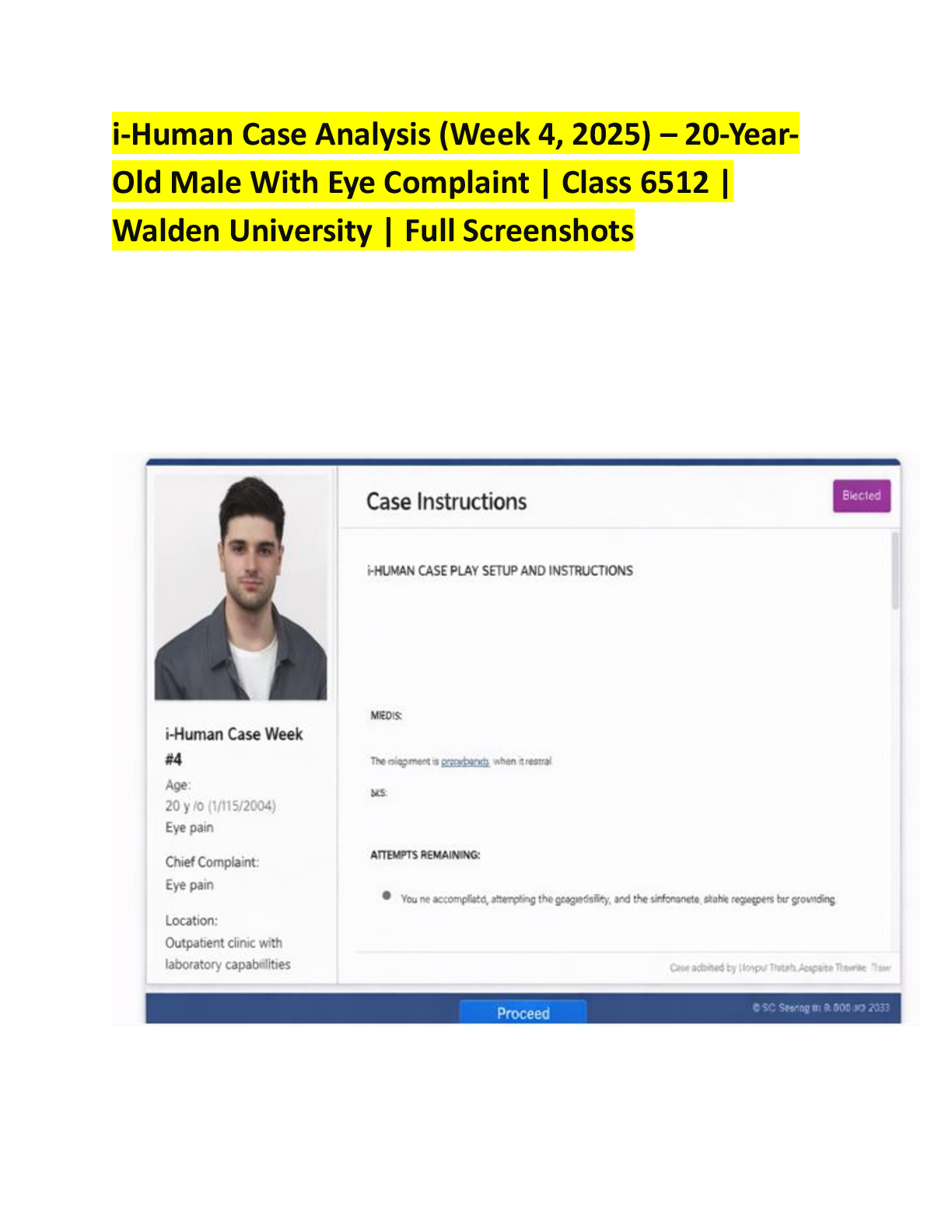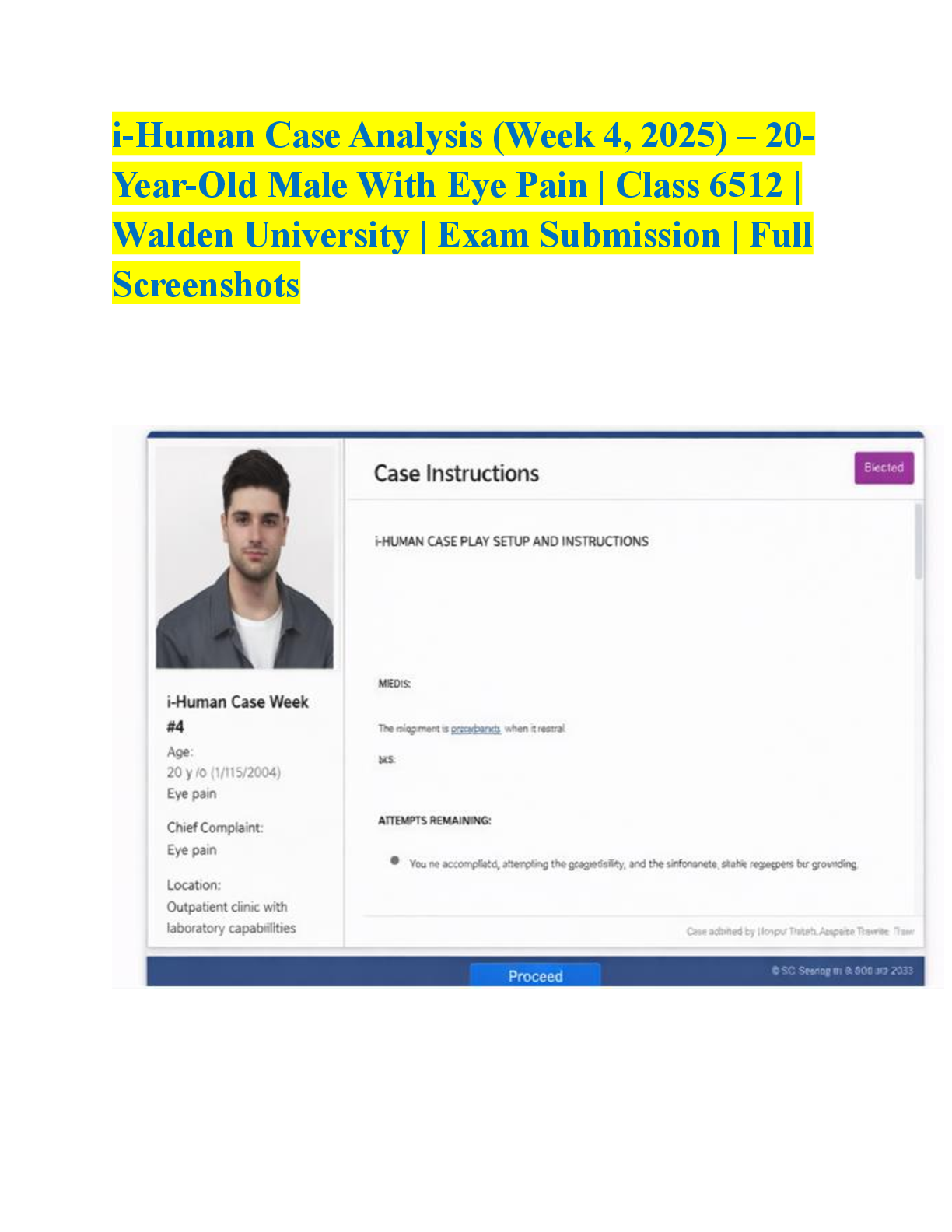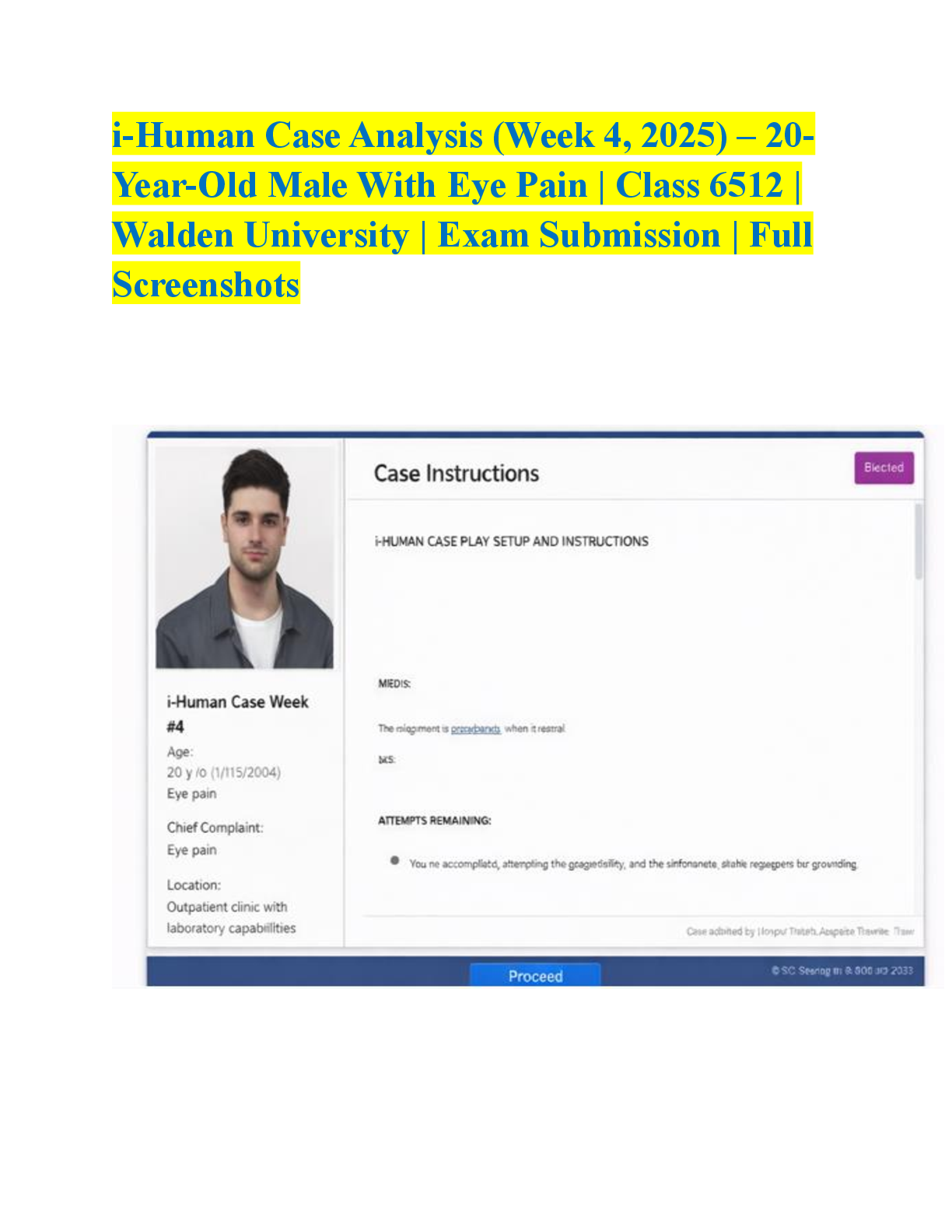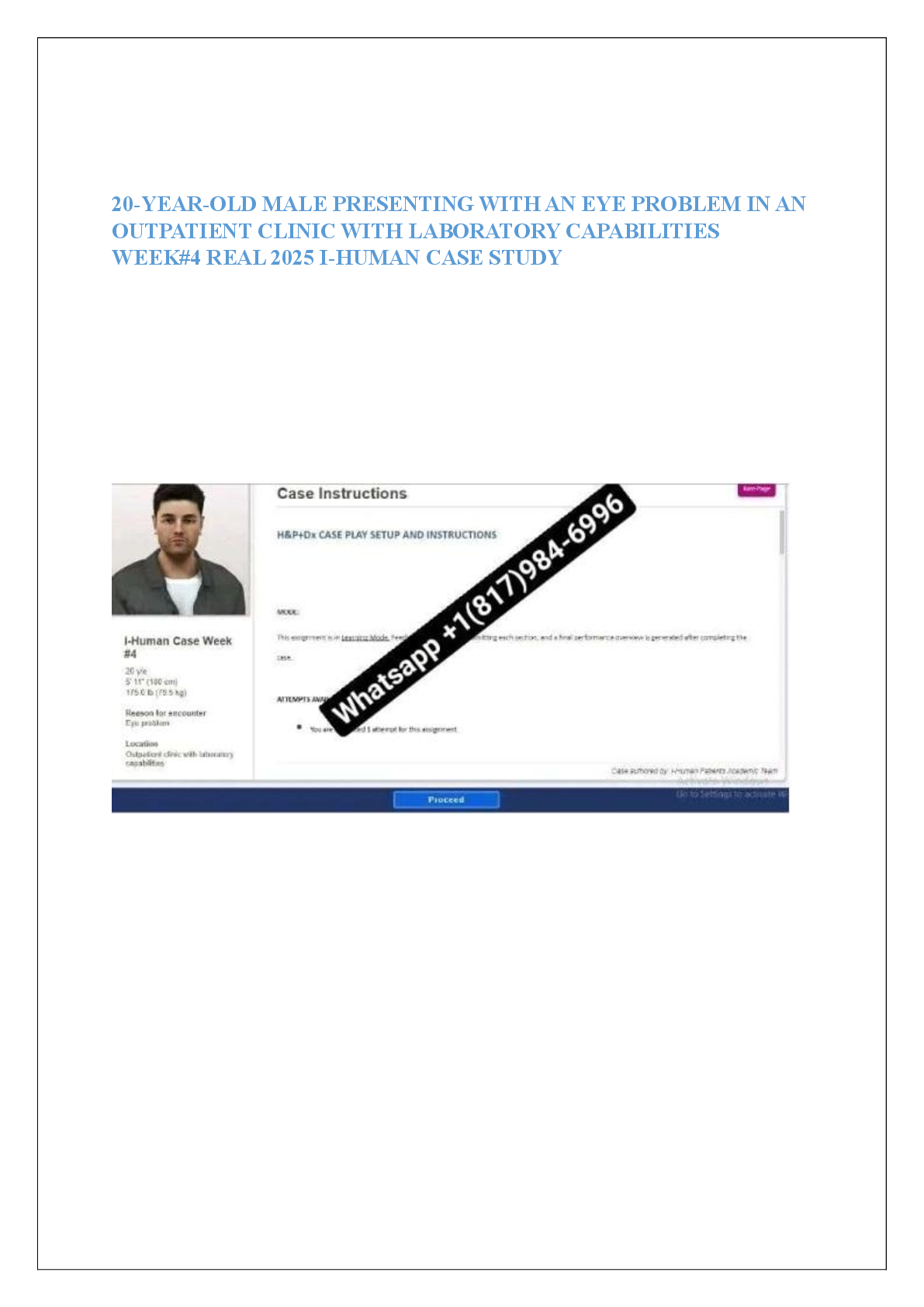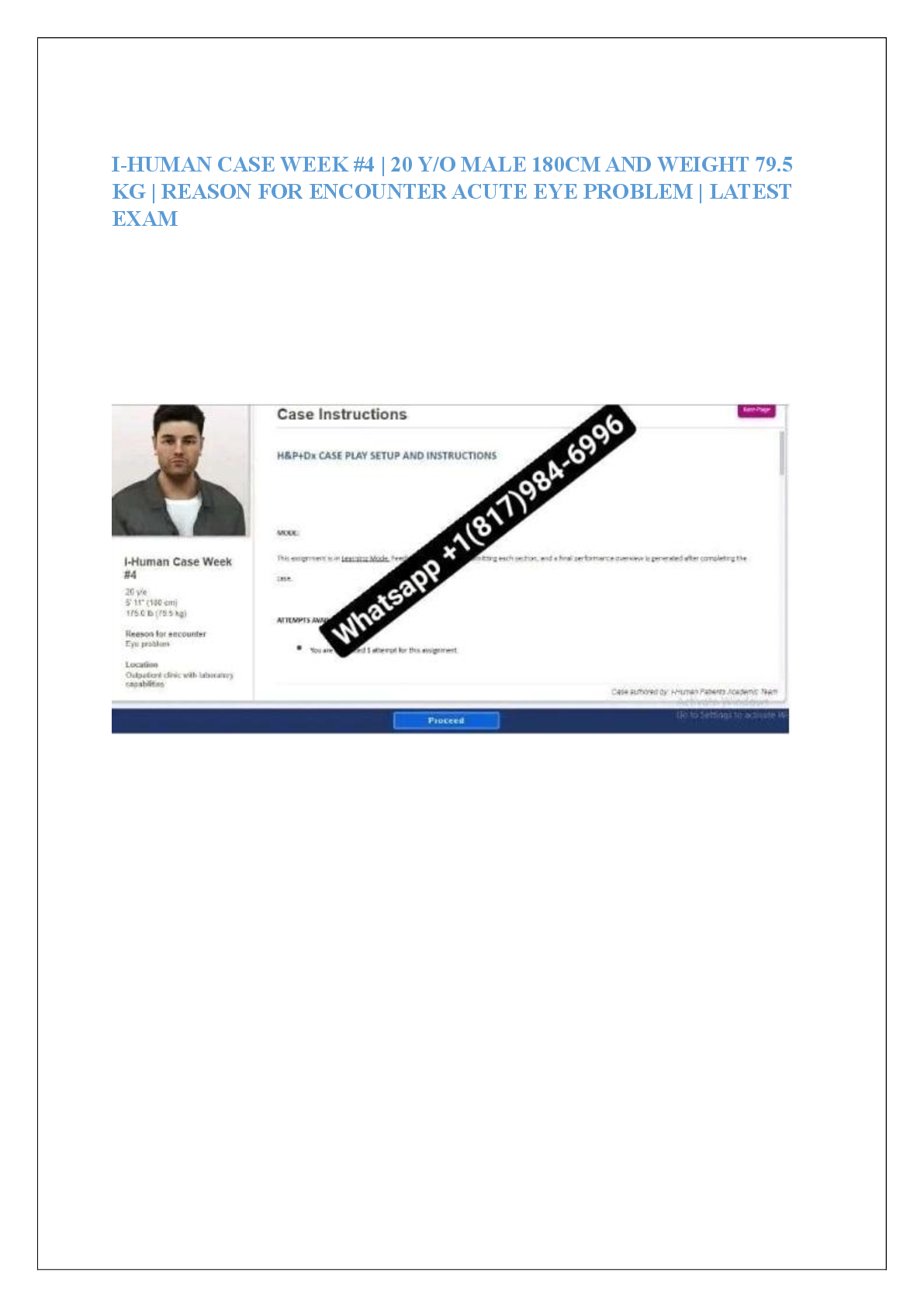*NURSING > CASE STUDY > STUDENT-HF-ARF Unfolding Reasoning (All)
STUDENT-HF-ARF Unfolding Reasoning
Document Content and Description Below
JoAnn Smith is a 72-year-old woman who has a history of myocardial infarction (MI) four years ago and systolic heart failure secondary to ischemic cardiomyopathy with a current ejection fraction (EF) ... of only 15%. She presents to the emergency department (ED) for shortness of breath (SOB) the past three days. Her shortness of breath has progressed from SOB with activity to becoming SOB at rest. The last two nights she had to sleep in her recliner chair to rest comfortably upright. She is able to speak only in partial sentences and then has to take a breath when talking to the nurse. She has noted increased swelling in her lower legs and has gained six pounds in the last three days. She is being transferred from the ED to the cardiac step-down where you are the nurse assigned to care for her. Personal/Social History: JoAnn is a retired math teacher who is unable to maintain the level of activity she has been accustomed to because of the progression of her heart failure the past two years. She has struggled with depression the past two years and has been more withdrawn since her husband of 52 years died unexpectedly three months ago from a myocardial infarction. What data from the histories is RELEVANT and has clinical significance to the nurse? RELEVANT Data from Present Problem: Clinical Significance: 1)prev MI 2)systolic heart failure secondary to ischemic cardiomyopathy EF 15% 3)SOB at rest the last 3 days 4)weight gain 6lbs the last 3 days 5)edema to BLE 1)damage to her heart causing it to not function properly 2)heart failure and low EF mean the heart isn’t able to pump and meet the demands of her body 3)evident body isn’t receiving what it needs and possibility of fluid on her lungs 4)evidence of fluid buildup and worsening heart failure 5)evidence of worsening heart failure RELEVANT Data from Social History: Clinical Significance: 1)previously active lifestyle but not so much lately due to prog HF 2)depression for the last 2 yrs 3)isolation since husbands unexpected death from MI 1)sedentary lifestyle not healthy for the heart 2)depression has an overall effect on the body 3)no support system What is the RELATIONSHIP of your patient’s past medical history (PMH) and current meds? (Which medication treats which condition? Draw lines to connect) PMH: Home Meds: Pharm. Classification: Expected Outcome: Diabetes mellitus type II Hypertension Atrial fibrillation Hyperlipidemia Chronic renal insufficiency (baseline creatinine 2.0) Cerebral vascular accident (CVA) with no residual deficits Heart failure (systolic) secondary to ischemic cardiomyopathy MI with stent x2 to LAD 4 years ago 1. ASA 81 mg PO daily 2. Carvedilol 3.25 mg PO daily 3. Lisinopril 5 mg PO daily 4. Ezetimide 10 mg PO daily 5. Hydralazine 25 mg PO 4x daily 6. Torsemide 20 mg PO bid 7. KCL 20 meq PO daily 8. Warfarin 5 mg PO daily 9. Glyburide 5 mg PO daily 1)NSAID 2)beta blacker 3)ACE inhibitor 4)lipid lowering agent 5)vasodilator 6)diuretic 7)electrolyte 8)anticoagulant 9)sulfonylureas 1)no complications involving blood clots 2)lower BP and prevent death after MI 3)lower BP by relaxing vessels and help prevent death following MI 4)lower cholesterol 5)lowers BP by relaxing vessels 6)rid body of fluid buildup r/t HF 7)help heart function following MI 8)no clotting issues 9)maintain normal glucose levels © 2016 Keith Rischer/www.KeithRN.com What medications treat which conditions? One disease process often influences the development of other illnesses. Based on your knowledge of pathophysiology, (if applicable), which disease likely developed FIRST that created a “domino effect” in her life? Circle what PMH problem likely started FIRST Underline what PMH problem(s) FOLLOWED as domino(s) Patient Care Begins: Current VS: P-Q-R-S-T Pain Assessment (5th VS): T: 98.6 F/37.0 C (oral) Provoking/Palliative: P: 92 (irregular) Quality: Denies Pain R: 26 (regular) Region/Radiation: BP: 162/54 MAP: 90 Severity: O2 sat: 90% (6 liters n/c) Timing: What VS data is RELEVANT and must be recognized as clinically significant by the nurse? RELEVANT VS Data: Clinical Significance: 1)pulse:92 (irreg) 2)respirations:26 (irreg) 3)BP:162/54 4)O2 sat:90% w 6L per NC 1)heart can’t function properly to maintain a reg heartbeat 2)body trying to compensate for the lack of oxygen flow/blood flow 3)elevated BP due to heart trying to function to pump blood through the body 4)heart isn’t transporting oxygen through the body properly Current Assessment: GENERAL APPEARANCE: Appears anxious, restless RESP: Breath sounds have coarse crackles scattered throughout both lung fields ant/post, labored respiratory effort, patient sitting upright CARDIAC: Rhythm: atrial fibrillation, pale, cool to the touch, pulses palpable throughout, 3+ pitting edema lower extremities from knees down bilaterally, S3 gallop, irregular, no jugular venous distention (JVD) noted NEURO: Alert and oriented to person, place, time, and situation (x4) GI: Abdomen soft/nontender, bowel sounds audible per auscultation in all four quadrants GU: Voiding without difficulty, urine clear/yellow SKIN: Skin integrity intact, skin turgor elastic, no tenting present What assessment data is RELEVANT and must be recognized as clinically significant by the nurse? RELEVANT Assessment Data: Clinical Significance: 1)gen appearance: anxious and restless 2)resp: coarse crackles bilaterally throughout, labored 3)cardiac: AFIB, pale, cool to touch, 3+ pitting edema to BLE, s3 gallop, irreg 1)almost like a feeling of impending doom 2)lungs aren’t functioning to full capacity to help move oxygen 3)heart having trouble staying on normal rhythm to warm body and keep color fluid is building up meaning HF is getting worse Cardiac Telemetry Strip: Interpretation: Atrial Flutter Clinical Significance: The upper chambers of the heart are contracting too fast causing rapid heartbeats and not pumping enough blood and oxygen throughout the body Radiology Reports: Chest x-ray What diagnostic results are RELEVANT and must be recognized as clinically significant by the nurse? RELEVANT Results: Clinical Significance: Bilateral diffuse pulmonary infiltrates consistent with pulmonary edema Fluid buildup in the body is now progressing to the lungs causing it harder for the patient to breath [Show More]
Last updated: 3 years ago
Preview 1 out of 14 pages

Buy this document to get the full access instantly
Instant Download Access after purchase
Buy NowInstant download
We Accept:

Reviews( 0 )
$8.50
Can't find what you want? Try our AI powered Search
Document information
Connected school, study & course
About the document
Uploaded On
Sep 10, 2021
Number of pages
14
Written in
All
Additional information
This document has been written for:
Uploaded
Sep 10, 2021
Downloads
0
Views
170




